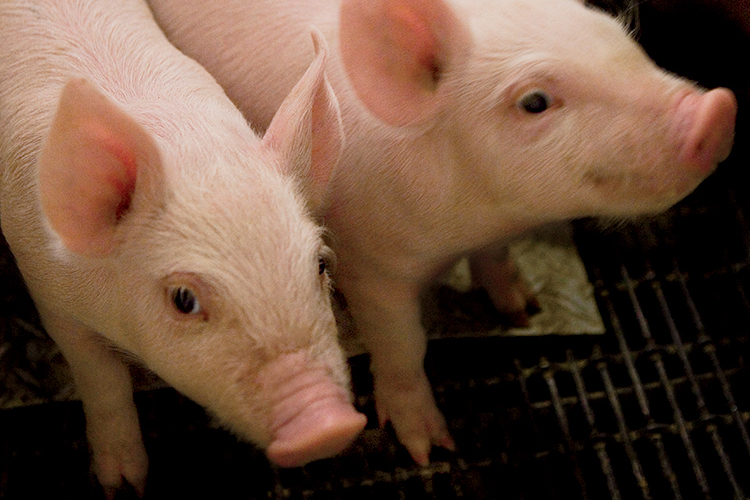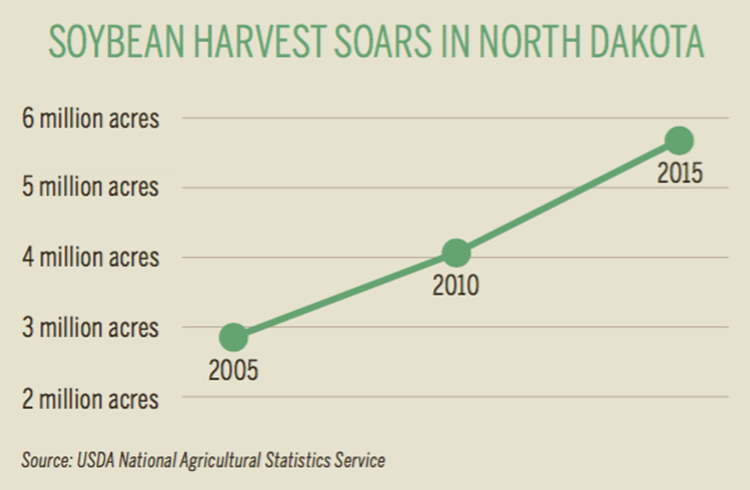Home > North Dakota > North Dakota Crops & Livestock > Soy and Swine: Working Together in North Dakota
Soy and Swine: Working Together in North Dakota
In partnership with: North Dakota Department of Agriculture
 Did you know at any given time there are nearly 140,000 pigs being raised in North Dakota? With each pig producing approximately 371 servings of pork, that’s a lot of meat. To raise those animals, North Dakota farmers rely on the availability of high-quality feed primarily made of soybean meal and corn. Thankfully, North Dakota farmers do a fantastic job of raising those crops, too. In fact, North Dakota ranks No. 8 in the U.S. in soybean production, with Cass County No. 1 in the nation for soybean harvested acres in 2015.
Did you know at any given time there are nearly 140,000 pigs being raised in North Dakota? With each pig producing approximately 371 servings of pork, that’s a lot of meat. To raise those animals, North Dakota farmers rely on the availability of high-quality feed primarily made of soybean meal and corn. Thankfully, North Dakota farmers do a fantastic job of raising those crops, too. In fact, North Dakota ranks No. 8 in the U.S. in soybean production, with Cass County No. 1 in the nation for soybean harvested acres in 2015.
“Pork and soybeans have a synergistic relationship, because soybeans are a critical part of every hog diet,” says Tamra Heins, director of the North Dakota Pork Council. “It’s hard to replicate what soy can do. When you extrude the oil from soybeans, the meal is what’s left, and that’s what is fed to swine along with corn. The corn is like the carbs, and the soy is like steak – it has high-quality protein.”
The relationship between pork and soybeans is one way agricultural commodities in North Dakota support one another. According to the North Dakota Soybean Council, livestock and poultry farmers are the largest customer for U.S. soybean meal, consuming 97 percent of soybean meal. That translates to the meal from more than a whopping 32 million acres of soybeans each year.
![ND pork [INFOGRAPHIC]](https://eadn-wc01-4177395.nxedge.io/wp-content/uploads/2020/05/Screen-Shot-2016-08-23-at-9.43.06-AM.jpg) German Farms
German Farms
Scott German of Oakes is a third-generation farmer who produces soybeans and corn, and finishes 14,000 pigs each year with his dad, Mick.
“My grandpa bought this farm in 1952 after he got out of the service,” German says. “I think farming is something that’s in your blood. My dad will soon be retirement age, and I see a lot of pride in his eyes when he shows my son how to run a piece of farm equipment.”
German and his wife, Denise, a pharmacist, have four boys, ages 8, 11, 13 and 15. They raise, or “finish,” pigs on contract, which means they get the pigs when they weigh about 40 pounds and grow them up to market weight, or between 265 and 280 pounds. The process takes about 120 days.
“Swine consume a lot of soybean meal, and the amount changes as they grow,” German says. “A starter pig gets feed with 35 to 40 percent soybean meal. As they get older, they don’t need as high protein, so it decreases to 15 to 20 percent.”
 German wants consumers to know that swine producers care about their animals and quality of life.
German wants consumers to know that swine producers care about their animals and quality of life.
“People hear a lot of negatives about animal welfare. They see someone mistreating an animal on the news, but that is the exception, not the norm in our industry,” he says. “For swine producers, animals are our livelihood and our income source. Ours is an antibiotic-free operation, meaning we treat sick pigs individually and care for them separately. If people took the time to visit with producers, they would find out how much we care for our animals.”
 Gibbens Farms
Gibbens Farms
In Cando, cousins Jim and Bruce Gibbens raise soybeans, corn, wheat and barley at their 12,000-acre Gibbens Farms. They are also partners in Sky-Can Ltd., a 6,000-head farrow to-finish hog operation that provides 45 full-time jobs. In 2015, they set a record with 160,000 baby pigs born.
“Bruce and I are fourth-generation farmers, and this year will mark the 134th crop at Gibbens Farms,” Jim Gibbens says. “Eight years ago, we partnered with Sky-Can, a Canadian company, to build our hog operation. We thought we should be more vertically integrated, and we wanted an outlet for all the corn we grow. We sell our corn exclusively to Sky-Can, and they process their own feed for the pigs, so it’s a win-win.”
Gibbens and his wife, Linda, have five grown daughters and one son, and together the family owns 10 businesses in Cando, including a partnership in a pasta company called Bektrom Foods/Cando Pasta LLC. Their businesses employ a total of about 120 people in their small community of 1,200.
“We love our community. You have to have a positive attitude to succeed, and there are a lot of positive attitudes around here, because we’re not willing to quit or give up,” Gibbens says. “When we have company picnics or Christmas parties, we have 200 people show up, and half of them are employees. I’m proud that people depend on us and that we can contribute back to our community.”



